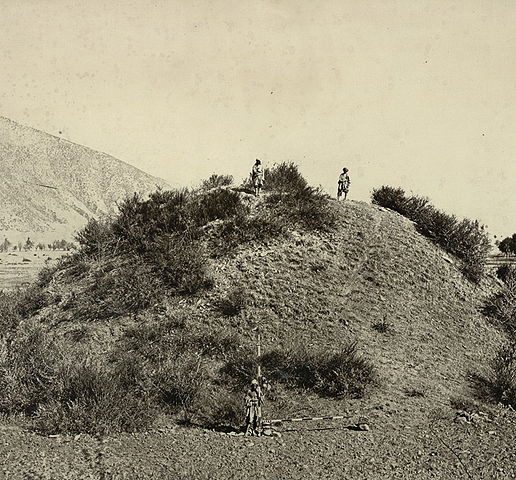 |
This is a file from the Wikimedia Commons. Information from its description page there is shown below.
Commons is a freely licensed media file repository. You can help.
|
Summary
Photograph of a Buddhist stupa mound near Baramulla in Jammu and Kashmir, taken by John Burke in 1868. Buddhism was established in Kashmir from the third century BC but declined by the 8th century AD, eclipsed by Hindu Vaishnavism and Shaivism. Two of the most important sites for Buddhist remains in the Kashmir valley are Harwan near Srinagar and Ushkur near Baramulla. Located 55 km from Srinagar, Baramulla, once an important trading centre under the British at the western entrance to the Kashmir valley, spreads along the banks of the Vitasta (Jhelum). On the left bank is the ancient site of Hushkapur (now Ushkur) said to have been founded by Huvishka, a ruler from the famed Kushana dynasty that ruled portions of Afghanistan and India during the first three centuries AD. When the 7th century Chinese traveller Hieuan Tsang entered Kashmir, he stayed at Ushkur and described it as a flourishing Buddhist centre. This general view of the unexcavated stupa, with two figures standing on the summit, and another at the base with measuring scales, is reproduced in Henry Hardy Cole's Archaeological Survey of India report, 'Illustrations of Ancient Buildings in Kashmir,' (1869), in which he wrote, 'The locality which includes the remains of a Monastery is called the 'Jayendra Vihar', and the erection is assigned by local tradition to one 'Praverasena' in A.D. 500. Excavation required.' Stupa bases and other remains were excavated at this mound, and among the discoveries were finely modelled terracotta heads. Downloaded from British Museum web site by Fowler&fowler «Talk» 02:23, 1 April 2007 (UTC)
- Originally uploaded to en:Wikipedia ( log)
Licensing
| Public domainPublic domainfalsefalse |
 |
This image (or other media file) is in the public domain because its copyright has expired.
This applies to Australia, the European Union and those countries with a copyright term of life of the author plus 70 years.
 You must also include a United States public domain tag to indicate why this work is in the public domain in the United States. Note that a few countries have copyright terms longer than 70 years: Mexico has 100 years, Colombia has 80 years, and Guatemala and Samoa have 75 years, Russia has 74 years for some authors. This image may not be in the public domain in these countries, which moreover do not implement the rule of the shorter term. Côte d'Ivoire has a general copyright term of 99 years and Honduras has 75 years, but they do implement the rule of the shorter term. You must also include a United States public domain tag to indicate why this work is in the public domain in the United States. Note that a few countries have copyright terms longer than 70 years: Mexico has 100 years, Colombia has 80 years, and Guatemala and Samoa have 75 years, Russia has 74 years for some authors. This image may not be in the public domain in these countries, which moreover do not implement the rule of the shorter term. Côte d'Ivoire has a general copyright term of 99 years and Honduras has 75 years, but they do implement the rule of the shorter term.
|
|
This file has been identified as being free of known restrictions under copyright law, including all related and neighboring rights.
|
File usage
The following pages on Schools Wikipedia link to this image (list may be incomplete):
This file contains additional information, probably added from the digital camera or scanner used to create or digitize it. If the file has been modified from its original state, some details may not fully reflect the modified file.
Schools Wikipedia was created by children's charity SOS Children. In 133 nations around the world, SOS Children's Villages works to bring better education and healthcare to families in desperate need of support. Want to learn more? Go to http://www.soschildrensvillages.org.uk/sponsor-a-child



